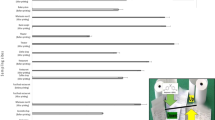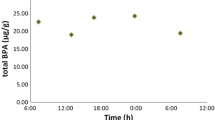Abstract
The Risk Assessment Committee of the European Chemical Agency released a scientific opinion alerting that the risk associated with dermal occupational exposure to bisphenol A (BPA) via thermal paper might not be adequately controlled because the estimated exposure was around twice the Derived No Effect Level (DNEL) and the European Commission will effectively restrict BPA in thermal paper as soon as 2020. Bisphenol S (BPS) is currently being used as a BPA surrogate and is already widespread in thermal paper receipts. Based on publically available information in the scientific literature, we assessed the risk associated with dermal BPS exposure via thermal paper for the general and occupational populations to compare with BPA situation. We developed two exposure scenarios; one based on the total excreted BPS and another on exposure estimations by transferring BPS from the thermal paper matrix to skin. Both scenarios yielded similar exposures for the general population (0.016–0.013 µg/kg bw/day), but the exposure estimated for the workers in the second scenario (0.96 µg/kg bw/day) was around 17-fold higher than that estimated for the workers in the first scenario. The systemic DNELs for the general and workers populations were 0.45 and 0.91 µg BPS/kg bw/day, respectively, which were 4.6- and 19-fold higher than the respective dermal DNELs. Risk Characterisation Ratio (RCR) (estimated exposure through urinary excretion compared with the systemic DNEL) in the first and most reliable scenario suggested that the risk was adequately controlled. In the second scenario, however, the RCR suggests that the risk might not be adequately controlled for both the general population and workers. This work raises the necessity of generate more toxicodynamic and toxicokinetic information, specially using dermal exposures, to properly assess the risk associated to dermal BPS exposure because the situation might presumably get worse after 2020.

Similar content being viewed by others
Abbreviations
- BMDL:
-
Benchmark dose level
- BMDL10:
-
Benchmark dose level lower confidence limit of 10%
- BPA:
-
Bisphenol A
- BPS:
-
Bisphenol S
- DNEL:
-
Derived no effect level
- EFSA:
-
European Food Safety Agency
- GLP:
-
Good Laboratory Practice
- HED:
-
Human equivalent dose
- HEDF:
-
Human equivalent dose adjustment factor
- LOAEL:
-
Lowest observed adverse effect level
- NOAEL:
-
No observed adverse effect level
- RAC:
-
Risk Assessment Committee of the European Chemical Agency
- RCR:
-
Risk characterisation ratio
References
CE (European Commission) (2006) Regulation (EC) No 1907/2006 of the European Parliament and of the Council of 18 December 2006 concerning the Registration, Evaluation, Authorisation and Restriction of Chemicals (REACH), establishing a European Chemicals Agency, amending Directive 1999/45/EC and repealing Council Regulation (EEC) No 793/93 and Commission Regulation (EC) No 1488/94 as well as Council Directive 76/769/EEC and Commission Directives 91/155/EEC, 93/67/EEC, 93/105/EC and 2000/21/EC. https://eur-lex.europa.eu/legal-content/EN/TXT/PDF/?uri=CELEX:02006R1907-20140410&from=ES. Accessed 26 Feb 2019
CE (European Commission) (2008) Regulation (EC) No 1272/2008 of the European Parliament and of the Council of 16 December 2008 on classification, labelling and packaging of substances and mixtures, amending and repealing Directives 67/548/EEC and 1999/45/EC, and amending Regulation (EC) No 1907/2006. https://eur-lex.europa.eu/legal-content/EN/TXT/PDF/?uri=CELEX:32008R1272&from=ES. Accessed 25 Feb 2019
Classification and Labelling European Inventory. https://echa.europa.eu/information-on-chemicals/cl-inventory-database. Accessed 26 Feb 2019
ECHA (European Chemicals Agency) (2012) Guidance on information requirements and chemical safety assessment Chapter R.8: characterisation of dose [concentration]-response for human health. https://echa.europa.eu/documents/10162/13632/information_requirements_r8_en.pdf. Accessed 25 Feb 2019
EFSA (European Food Safety Agency) Panel on Food Contact Materials, Enzymes, Flavourings and Processing Aids (2015) Scientific Opinion on the risks to public health related to the presence of bisphenol A (BPA) in foodstuffs: executive summary. EFSA J 13(1):3978. https://doi.org/10.2903/j.efsa.2015.3978
Eladak S, Grisin T, Moison D, Guerquin MJ, N’Tumba-Byn T, Pozzi-Gaudin S, Benachi A, Livera G, Rouiller-Fabre V, Habert R (2015) A new chapter in the bisphenol A story: bisphenol S and bisphenol F are not safe alternatives to this compound. Fertil Steril 103(1):11–21. https://doi.org/10.1016/j.fertnstert.2014.11.005
Karrer C, Roiss T, von Goetz N, Gramec Skledar D, Peterlin Mašič L, Hungerbühler K (2018) Physiologically based pharmacokinetic (PBPK) modeling of the bisphenols BPA, BPS, BPF, and BPAF with new experimental metabolic parameters: comparing the pharmacokinetic behavior of BPA with its substitutes. Environ Health Perspect 126(7):077002. https://doi.org/10.1289/EHP2739
Krishnan K, Gagné M, Nong A, Aylward LL, Hays SM (2010) Biomonitoring equivalents for bisphenol A (BPA). Regul Toxicol Pharmacol 58(1):18–24. https://doi.org/10.1016/j.yrtph.2010.06.005
Liao C, Liu F, Kannan K (2012a) Bisphenol S, a new bisphenol analogue, in paper products and currency bills and its association with bisphenol A residues. Environ Sci Technol 46(12):6515–6522. https://doi.org/10.1021/es300876n
Liao C, Liu F, Alomirah H, Loi VD, Mohd MA, Moon HB, Nakata H, Kannan K (2012b) Bisphenol S in urine from the United States and seven Asian countries: occurrence and human exposures. Environ Sci Technol 46(12):6860–6866. https://doi.org/10.1021/es301334j
Moreman J, Lee O, Trznadel M, David A, Kudoh T, Tyler CR (2017) Acute toxicity, teratogenic, and estrogenic effects of bisphenol A and its alternative replacements bisphenol S, bisphenol F, and bisphenol AF in zebrafish embryo-larvae. Environ Sci Technol 51(21):12796–12805. https://doi.org/10.1016/10.1021/acs.est.7b03283
Ndaw S, Remy A, Denis F, Marsan P, Jargot D, Robert A (2018) Occupational exposure of cashiers to bisphenol S via thermal paper. Toxicol Lett 298:106–111. https://doi.org/10.1016/j.lfs.2018.10.044
Oh J, Choi JW, Ahn YA, Kim S (2018) Pharmacokinetics of bisphenol S in humans after single oral administration. Environ Int 112:127–133. https://doi.org/10.1016/j.envint.2017.11.020
Rahmani S, Pour Khalili N, Khan F, Hassani S, Ghafour-Boroujerdi E, Abdollahi M (2018) Bisphenol A: what lies beneath its induced diabetes and the epigenetic modulation? Life Sci 214:136–144. https://doi.org/10.1016/j.lfs.2018.10.044
REACH Register: 4,4′-isopropylidenediphenol (bisphenol A) registration dossier. https://echa.europa.eu/registration-dossier/-/registered-dossier/15752. Accessed 25 Feb 2019
REACH Register: 4,4′-sulphonyldiphenol (bisphenol S) registration dossier. https://echa.europa.eu/es/registration-dossier/-/registered-dossier/14986. Accessed 25 Feb 2019
Risk Assessment Committee of the European Chemical Agency (2015) Opinion on an Annex XV dossier proposing restrictions on bisphenol A. https://echa.europa.eu/documents/10162/9ce0977b-3540-4de0-af6d-16ad6e78ff20. Accessed 26 Feb 2019
Rocha BA, Azevedo LF, Gallimberti M, Campiglia AD, Barbosa F Jr (2015) High levels of bisphenol A and bisphenol S in Brazilian thermal paper receipts and estimation of daily exposure. J Toxicol Environ Health A 78(18):1181–1188. https://doi.org/10.1016/10.1080/15287394.2015.1083519
Rochester JR, Bolden AL (2015) Bisphenol S and F: a systematic review and comparison of the hormonal activity of bisphenol A substitutes. Environ Health Perspect 123(7):643–650. https://doi.org/10.1289/ehp.1408989
Russo G, Barbato F, Grumetto L (2017) Monitoring of bisphenol A and bisphenol S in thermal paper receipts from the Italian market and estimated transdermal human intake: a pilot study. Sci Total Environ 599–600:68–75. https://doi.org/10.1016/j.scitotenv.2017.04.192
Thayer KA, Taylor KW, Garantziotis S, Schurman SH, Kissling GE, Hunt D, Herbert B, Church R, Jankowich R, Churchwell MI, Scheri RC, Birnbaum LS, Bucher JR (2016) Bisphenol A, bisphenol S, and 4-hydroxyphenyl 4-isoprooxyphenylsulfone (BPSIP) in urine and blood of cashiers. Environ Health Perspect 124(4):437–444. https://doi.org/10.1289/ehp.1409427
Tyl RW, Myers CB, Marr MC, Thomas BF, Keimowitz AR, Brine DR, Veselica MM, Fail PA, Chang TY, Seely JC, Joiner RL, Butala JH, Dimond SS, Cagen SZ, Shiotsuka RN, Stropp GD, Waechter JM (2002) Three-generation reproductive toxicity study of dietary bisphenol A in CD Sprague-Dawley rats. Toxicol Sci 68(1):121–146. https://doi.org/10.1093/toxsci/68.1.121
Tyl RW, Myers CB, Marr MC, Sloan CS, Castillo NP, Veselica MM, Seely JC, Dimond SS, Van Miller JP, Shiotsuka RN, Beyer D, Hentges SG, Waechter JM Jr (2008) Two-generation reproductive toxicity study of dietary bisphenol A in CD-1 (Swiss) mice. Toxicol Sci 104(2):362–384. https://doi.org/10.1093/toxsci/kfn084
Waidyanatha S, Black SR, Snyder RW, Yueh YL, Sutherland V, Patel PR, Watson SL, Fennell TR (2018) Disposition and metabolism of the bisphenol analogue, bisphenol S, in Harlan Sprague Dawley rats and B6C3F1/N mice and in vitro in hepatocytes from rats, mice, and humans. Toxicol Appl Pharmacol 351:32–45. https://doi.org/10.1016/j.taap.2018.05.008
Author information
Authors and Affiliations
Corresponding author
Ethics declarations
Conflict of interest
The authors declare no conflict of interest.
Additional information
Publisher's Note
Springer Nature remains neutral with regard to jurisdictional claims in published maps and institutional affiliations.
Rights and permissions
About this article
Cite this article
Sogorb, M.A., Estévez, J. & Vilanova, E. Case study: Is bisphenol S safer than bisphenol A in thermal papers?. Arch Toxicol 93, 1835–1852 (2019). https://doi.org/10.1007/s00204-019-02474-x
Received:
Accepted:
Published:
Issue Date:
DOI: https://doi.org/10.1007/s00204-019-02474-x




